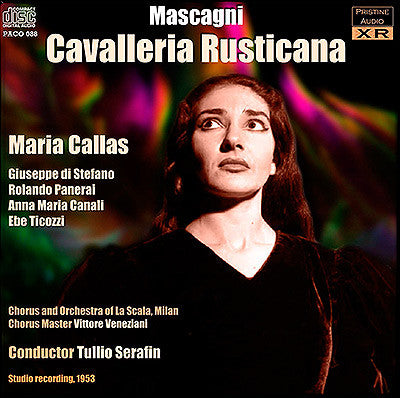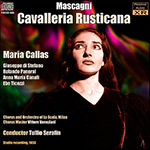
This album is included in the following sets:
This set contains the following albums:
- Producer's Note
- Full Track Listing
- Cover Art
"She makes the Easter Hymn sound as one had forgotten it could sound" - Gramophone
Maria Callas in stunning form in this entirely revitalised, XR-remastered Cavalleria Rusticana
For Maria Callas's studio career, 1953 set out a working pattern which must have been deemed successful enough for it to be followed in 1954 in almost exactly the same manner. She recorded five full operas for EMI in both 1953 and 1954, and in each case the "middle" recording was a shorter, single-act work. Appropriately enough, the two shorter works in question are frequently linked together: Leoncavallo's Pagliacci, recorded in June 1954, and the present recording of Mascagni's Cavalleria Rusticana, made in June and August, 1953. Three of the soloists appear on both recordings, together with the La Scala orchestra and chorus under Serafin. Yet although they were later paired in reissue format, the two were originally released separately, with Cavalleria Rusticana being possibly the first British LP issue to span three sides, with the fourth side left blank and the second disc sold at a lower price.
As with other recordings Callas made in 1953 there was much to be done to improve sound quality. What began as a dull, flat, lifeless recording has, following XR remastering at the assiduous use of the acoustic properties of one of the world's finest opera houses, totally blossomed. Indeed, in side-by-side comparison it's hard to believe the former could possibly have led to the latter. I've done my best to contain occasional peak distortion in the very loudest sections (this is also apparent on EMI's CD issues so I assume is inherent in the master recording itself). This aside, this Cavalleria now bcecomes a wonderful, glowing artefact, a particularly fine recording.
Andrew Rose
MASCAGNI Cavalleria Rusticana
Text: Giovanni Targiono-Tozzetti & Guido Menasci after the short story and play by Giovanni Verga
Recorded 16-25 June and 3-4 August, 1953 at Basilica di Sant'Eufemia, Milan, Italy
First issued in the UK in 1954 as Columbia LPs 33CXS1182/3
Maria Callas - Santuzza
Giuseppe di Stefano - Turridu
Rolando Panerai - Alfio
Anna Maria Canali - Lola
Ebe Ticozzi - Mamma Lucia
Chorus and Orchestra of La Scala, Milan
Chorus Master Vittore Veneziani
Conductor Tullio Serafin
Fanfare & Gramophone Historic Reviews
The music comes at you characterised, experienced and weighted with an artistry wholly out of the ordinary
This recording was first issued on LP on Angel Records in 1953. Harold D. Rosenthal reviewed it in Opera magazine in November 1954. Rosenthal admired Callas, but thought Di Stefano was miscast, although he admired his singing of the aria “Addio alla madre.” He also liked Panerai and was satisfied with Serafin’s conducting.
Once again we have a remastering of this old recording, by (no relation) Andrew Rose. Callas sings well. Michael Scott says in a review of the performance that she is an excellent Santuzza, and I agree. Di Stefano is acceptable although his lyric tenor is miscast for a role that requires a dramatic tenor. Panerai is a good Alfio and Serafin is a fine conductor.
As usual Pristine Audio offers no booklet. On the inside of the cover there is a copy of brief notes about the performance from a 1954 review published in Gramophone magazine in 1954, and an explanation of the recording by A. Rose. On the back there is a listing of the bands and advice as to how to receive a full catalog.
The sound is loud and clear. I have
not compared it with my original LP recording. It has also been
previously released on CD. Anyone who is interested in collecting
recordings of Callas and does not have the previous releases is
recommended to get this disc. There are many recording of this opera
that feature excellent singers and conductors, so this one is for those
who collect Callas.
Bob Rose
This article originally appeared in Issue 37:1 (Sept/Oct 2013) of Fanfare Magazine.
Before discussing the artistic merits of this latest and third LP Cavalleria Rusticana,
note the price. Here is Cav. all on its own on three sides, two discs,
which means that 33CXS1182 is the first single-sided LP to be issued in
this country. People with mixed feelings, noting that the price is
appropriately lower, may also regret that the fourth side is not, in
fact, an operatic recital by Callas! It may be recalled that this is the
case with the Decca Cav., except that there the artist is Del Monaco,
which is another story. My view is that the decision not to "inflict" a
filler on us shows good sense and is a lead by Columbia which I trust
will be followed.
If you bought the second record on its own
you would still hear a sizeable portion of an opera which is, so to say,
a late starter. Side two starts with the Easter Hymn and side three
with Santuzza, after the row at the church door, turning to Alfio and in
vulgar parlance "spilling the beans"; followed by Alfio's vow of
vengeance, intermezzo, chorus, men's quarrel and Di Stefano's powerful
"Addio alia madre". But what I think instantly strikes you is that in
the rather conventional opening passage of Santuzza's distress you seem
to be hearing the music sung for the first time. Callas is an
exceptional artist in this creative artistry if in nothing else. Elena
Nicolai (Decca) makes it sound very ordinary; "just another of
Santuzza's tearful moments". Milanov (H.M.V.) sings it most touchingly,
with a couple of really beautiful high notes. Whether Callas's
interpretation strikes you as "beautiful" or not, it is arresting. Just
as in her Lucia, whatever the shortcomings, she suddenly caused you to
hear some phrase like "Alfin son tuo" at the opening of the Mad Scene
where one had hardly noticed it before, so here in page after page of
this durable favourite, the music comes at you characterised,
experienced and weighted with an artistry wholly out of the ordinary.
Against this you must reckon that quite a number of the notes, in an
uneven scale, are overloaded, ill-placed or pinched, with an
unpredictable or hooty quality. To ignore these may be easier for some
people than others, but to deny them in the wish to canonize a
superlative artist and raise her above all criticism seems to me
impossible. Enough that she makes the solo "Voi lo sapete" deeply
affecting, and the quarrel hair-raising and with the superb amplitude of
Maestro Serafin's conception, she makes the Easter Hymn sound as one
had forgotten it could sound. The tempi are on the slow side by some
reckonings, but there is nothing scamped or slapdash about the
performance, no suggestion of a bawling match. The chorus are not
perfect and the baritone is rather a crude singer. Otherwise the only
matter in question is whether Di Stefano is superior as Turiddu to
Björling (H.M.V.). He has a natural advantage over the Swede in his
ringing and clear enunciation of the Italian text. And though he is not
always so stylish or so musical a singer as Björling, he scores several t
imes; e.g. right at the start, the Siciliana is more poetically sung -
it is Björling's poorest moment; and the Italian's pathos is more
elemental. It is finally a matter of personal taste whether you prefer
this new version to the H.M.V. It is way ahead of the Decca.
P.H-W., The Gramophone, October 1954

